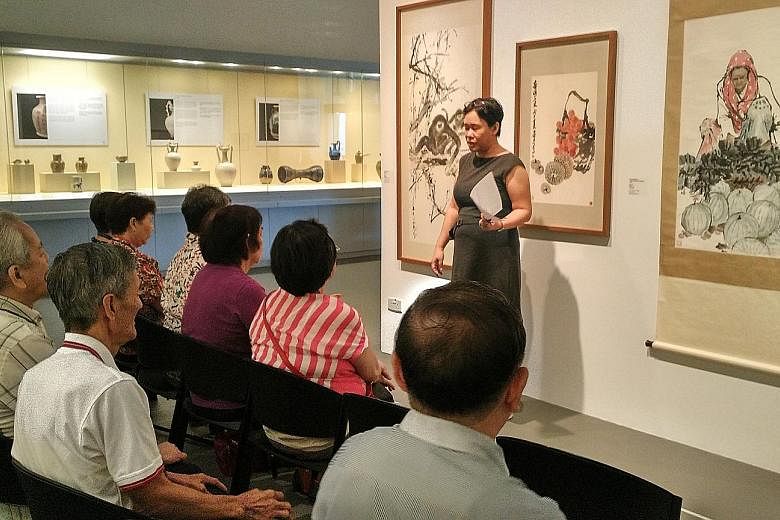Museum volunteer Tan Ai Yea is used to showing visitors works of art. The 39-year-old introduces up to eight paintings during her usual one-hour guided tour at the National Gallery Singapore.
Recently, however, she had the rapt attention of a silver-haired audience for almost an hour as they discussed one painting.
Pioneer artist Liu Kang's Life By The River got them reminiscing about their kampung days.
At least two museums here - the National Gallery Singapore and NUS Museum - are using their art to engage seniors at risk of dementia, in a bid to prevent or delay the onset of the disease.
The programme is part of a study that will use brain scans and chromosome analysis, among other measures, to gauge if this form of art therapy works.
Said the study's adviser, Professor Kua Ee Heok of the National University of Singapore Yong Loo Lin School of Medicine: "Professor Tommy Koh, who is ambassador- at-large, read a piece about the Museum of Modern Art (MoMA) in New York engaging the elderly with dementia with its art works, and asked me if we could do something like that.
"But I was more excited about doing it to prevent dementia, so we picked people who were at risk of dementia."
A group of 24 participants from a larger study - the ongoing 10-year Jurong Ageing Study that aims to cut depression and dementia rates in the elderly residents of Jurong - were selected to be part of this programme that started in July.
Based on their health conditions - diabetes, hypertension and family history of dementia - these seniors were deemed to be at a higher risk of getting dementia.
Six volunteer museum guides were specifically trained in group therapy to understand group dynamics, know how to elicit emotions and use the paintings to relate to the memories and life experiences of the participants.
Said Ms Tan: "For Liu Kang's painting, they recalled how there were no television and lights in the houses, and some could point out that they used to live nearby.
"Many, if not all of them, have not been to the Gallery before, and it is great to see them enjoying themselves rather than treating this as a task."
Half of the participants viewed the painting by Liu Kang in one session in July, and the rest had a discussion on another painting - Here They Come! by Koeh Sia Yong.
It shows old-time street hawkers running away from presumably the authorities. So far, four museum sessions have taken place.
The seniors go to the museums almost weekly for this type of art reminiscence therapy.
They also participate in hands-on art sessions in Jurong.
Brain scans and readings of anxiety levels, as well as memory and cognitive functions, are taken before the start of the programme, three months later and at the end of the nine-month project.
MoMA started its programme for early- and moderate-stage dementia patients and their caregivers in 2006.
It published a study in 2009 that provides the first scientific evidence of overall improvement in mood for most of the participants, as well as intellectual stimulation and positive social interaction.
As the local study is ongoing, researchers declined requests to speak to the participants, as that may affect the results of the study.
Mr Low Sze Wee, a director at National Gallery Singapore, said: "Working with Prof Kua and his team offered an appropriate opportunity for us to realise our mission by drawing on rigorous research to design meaningful programmes for visitors."


